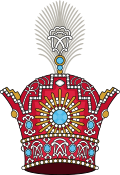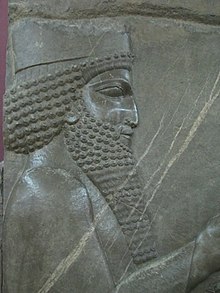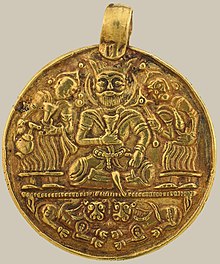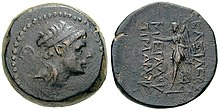
Shah is a royal title that was historically used by the leading figures of Iranian monarchies. It was also used by a variety of Persianate societies, such as the Ottoman Empire, the Kazakh Khanate, the Khanate of Bukhara, the Emirate of Bukhara, the Mughal Empire, the Bengal Sultanate, historical Afghan dynasties, and among Gurkhas. Rather than regarding himself as simply a king of the concurrent dynasty, each Iranian ruler regarded himself as the Shahanshah or Padishah in the sense of a continuation of the original Persian Empire.
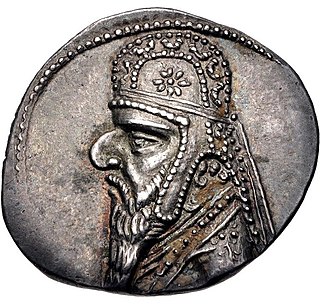
Mithridates II was king of the Parthian Empire from 124 to 91 BC. Considered one of the greatest of his dynasty to ever rule, he was known as Mithridates the Great in antiquity.

Arsaces I was the first king of Parthia, ruling from 247 BC to 217 BC, as well as the founder and eponym of the Arsacid dynasty of Parthia. The leader of the Parni, one of the three tribes of the Dahae confederacy, Arsaces founded his dynasty in the mid-3rd century BC when he conquered the satrapy of Parthia from Andragoras, who had rebelled against the Seleucid Empire. He spent the rest of his reign consolidating his rule in the region, and successfully stopped the Seleucid efforts to reconquer Parthia. Due to Arsaces' achievements, he became a popular figure amongst the Arsacid monarchs, who used his name as a royal honorific. By the time of his death, Arsaces had laid the foundations of a strong state, which would eventually transform into an empire under his great-grandnephew, Mithridates I, who assumed the ancient Near Eastern royal title of King of Kings. Arsaces was succeeded by his son Arsaces II.

Mithridates I, also known as Mithridates I the Great, was king of the Parthian Empire from 165 BC to 132 BC. During his reign, Parthia was transformed from a small kingdom into a major political power in the Ancient East as a result of his conquests. He first conquered Aria, Margiana and western Bactria from the Greco-Bactrians sometime in 163–155 BC, and then waged war with the Seleucid Empire, conquering Media and Atropatene in 148/7 BC. In 141 BC, he conquered Babylonia and held an official investiture ceremony in Seleucia. The kingdoms of Elymais and Characene shortly afterwards became Parthian vassals. In c. 140 BC, while Mithridates was fighting the nomadic Saka in the east, the Seleucid king Demetrius II Nicator attempted to regain the lost territories; initially successful, he was defeated and captured in 138 BC, and shortly afterwards sent to one of Mithridates I's palaces in Hyrcania. Mithridates I then punished Elymais for aiding Demetrius, and made Persis a Parthian vassal.

The Buyid dynasty, also spelled Buwayhid, was a Zaydi and, later, Twelver Shia dynasty of Daylamite origin, which mainly ruled over central and southern Iran and Iraq from 934 to 1062. Coupled with the rise of other Iranian dynasties in the region, the approximate century of Buyid rule represents the period in Iranian history sometimes called the "Iranian Intermezzo".

Ardashir I, also known as Ardashir the Unifier, was the founder of the Persian Sasanian Empire. He was also Ardashir V of the Kings of Persis, until he founded the new empire. After defeating the last Parthian shahanshah Artabanus IV on the Hormozdgan plain in 224, he overthrew the Arsacid dynasty and established the Sasanian dynasty. Afterwards, Ardashir called himself "shahanshah" and began conquering the land that he called Iran.
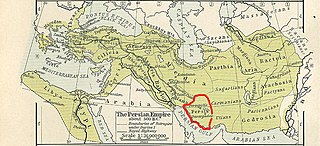
Persis, also called Persia proper, is the Fars region, located to the southwest of modern-day Iran, now a province. The Persians are thought to have initially migrated either from Central Asia or, more probably, from the north through the Caucasus. They would then have migrated to the current region of Persis in the early 1st millennium BC. The country name Persia was derived directly from the Old Persian Parsa.
Great king, and the equivalent in many languages, refers to historical titles of certain monarchs, suggesting an elevated status among the host of kings and princes.

Artabanus I, incorrectly known in older scholarship as Artabanus II, was king of the Parthian Empire, ruling briefly from c. 127 to 124/3 BC. His short reign ended abruptly when he died during a battle against the Yuezhi in the east. He was succeeded by his son Mithridates II.

Istakhr was an ancient city in Fars province, five kilometres north of Persepolis in southwestern Iran. It flourished as the capital of the Persian Frataraka governors and Kings of Persis from the third century BC to the early 3rd century AD. It reached its apex under the Sasanian Empire, and was the hometown of the Sasanian dynasty. Istakhr briefly served as the first capital of the Sasanian Empire from 224 to 226 AD and then as principal city, region, and religious centre of the Sasanian province of Pars.
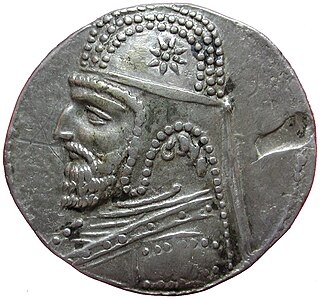
Orodes I, was king of the Parthian Empire from 80 to 75 BC. He was the son and heir of Gotarzes I. His reign is relatively obscure. His throne may have been usurped in 87–80 BC by his supposed uncle Mithridates III, however, this has found little support in scholarship. Of his military activities, it is known that Orodes I re-established Parthian rule in Elymais in 78 BC, which had been independent since 81/80 BC. Orodes I later lost the throne to the aged Parthian prince Sinatruces, who belonged to a different branch of the royal Arsacid family.
The Orontid dynasty, also known as the Eruandids or Eruandunis, ruled the Satrapy of Armenia until 330 BC and the Kingdom of Armenia from 321 BC to 200 BC. The Orontids ruled first as client kings or satraps of the Achaemenid Empire and after the collapse of the Achaemenid Empire established an independent kingdom. Later, a branch of the Orontids ruled as kings of Sophene and Commagene. They are the first of the three royal dynasties that successively ruled the antiquity-era Kingdom of Armenia.

The Parthian Empire, also known as the Arsacid Empire, was a major Iranian political and cultural power centered in ancient Iran from 247 BC to 224 AD. Its latter name comes from its founder, Arsaces I, who led the Parni tribe in conquering the region of Parthia in Iran's northeast, then a satrapy (province) under Andragoras, who was rebelling against the Seleucid Empire. Mithridates I greatly expanded the empire by seizing Media and Mesopotamia from the Seleucids. At its height, the Parthian Empire stretched from the northern reaches of the Euphrates, in what is now central-eastern Turkey, to present-day Afghanistan and western Pakistan. The empire, located on the Silk Road trade route between the Roman Empire in the Mediterranean Basin and the Han dynasty of China, became a center of trade and commerce.

Commagene was an ancient Greco-Iranian kingdom ruled by a Hellenized branch of the Iranian Orontid dynasty that had ruled over Armenia. The kingdom was located in and around the ancient city of Samosata, which served as its capital. The Iron Age name of Samosata, Kummuh, probably gives its name to Commagene.

Parthia is a historical region located in northeastern Greater Iran. It was conquered and subjugated by the empire of the Medes during the 7th century BC, was incorporated into the subsequent Achaemenid Empire under Cyrus the Great in the 6th century BC, and formed part of the Hellenistic Seleucid Empire after the 4th-century BC conquests of Alexander the Great. The region later served as the political and cultural base of the Eastern Iranian Parni people and Arsacid dynasty, rulers of the Parthian Empire. The Sasanian Empire, the last state of pre-Islamic Iran, also held the region and maintained the seven Parthian clans as part of their feudal aristocracy.
Lists of ancient kings are organized by region and peoples, and include kings recorded in ancient history and in mythology.
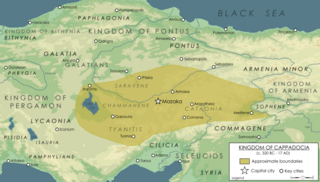
Cappadocia was a Hellenistic-era Iranian kingdom centered in the historical region of Cappadocia in Asia Minor. It developed from the former Achaemenid satrapy of Cappadocia, and it was founded by its last satrap, Ariarathes. Throughout its history, it was ruled by three families in succession; the House of Ariarathes (331–96 BC), the House of Ariobarzanes (96–36 BC), and lastly that of Archelaus (36 BC–17 AD). In 17 AD, following the death of Archelaus, during the reign of Roman emperor Tiberius (14–37 AD), the kingdom was incorporated as a Roman province.

Frataraka is an ancient Persian title, interpreted variously as “leader, governor, forerunner”. It is an epithet or title of a series of rulers in Persis from 3rd to mid 2nd century BC, or alternatively between 295 and 220 BC, at the time of the Seleucid Empire, prior to the Parthian conquest of West Asia and Iran. Studies of frataraka coins are important to historians of this period.

The Kings of Persis, also known as the Darayanids, were a series of Persian kings, who ruled the region of Persis in southwestern Iran, from the 2nd century BCE to 224 CE. They ruled as vassal kings of the Parthian Empire, until they toppled them and established the Sasanian Empire. They effectively formed some Persian dynastic continuity between the Achaemenid Empire and the Sasanian Empire.

